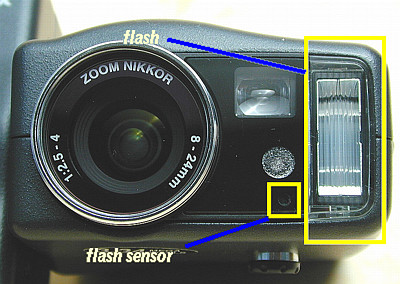
Nikon Coolpix 990 has an internal flash on the lens unit. See the image below. Between this internal flash and the on-camera lens is the sensor for measuring the intensity of flash light exposure. Therefore, flash metering is not TTL (i.e., through-the-lens). When you turn the camera on, the internal flash is set to the automatic mode. That is, when the available light is insufficient for a correct exposure, the internal flash fires.

The power of a flash is given by a guide number which is defined as follows:

where f-number is the x.y in an aperture value Fx.y. A GN has a unit either in meter m or in feet ft, and is in general calibrated at ISO 100. The Coolpix 990 internal flash has a GN of 9/30 (at ISO 100, m/ft). This means Coolpix 990's internal flash has a GN of 9 (resp., 30) if m (resp., ft) is used for measuring subject to flash distance.
Guide number is a given number. Thus, if you know the subject to flash distance, you can calculate the aperture to be used for a correct exposure. For example, suppose 990 is used to take a photo of a subject that is 10 ft away from the camera (and hence the flash), the f-number is (30 ft)/(10ft) = 3. That is, F3.0 should be used for a correct exposure. This is a problem of Coolpix 990, because F3.0 is almost the largest aperture. Moreover, F3.0 cannot be achieved if the lens is zoomed all the way in, since the maximum aperture in this case is F4.0! In fact, since the maximum aperture of the on-camera lens is F2.5, the maximum distance within which you can get a correctly exposed image using the internal flash is 30/2.5 = 12 ft. If you use the tele end of the on-camera lens, this distance reduces to 7.5 ft. Note that the relation of GN shown above does not hold for close-up work.
Fortunately, with the help of the internal flash meter, we do not have to worry about the calculation of the aperture. If this calculation is required, you have to enter the M-REC mode, use Aperture-Priority, determine the flash to subject distance (e.g., use Manual Focus), and use this distance to set an appropriate aperture.
There are five different flash settings available. They can be used in both A-REC and M-REC. Each flash setting is indicated by a special icon which is shown on the control panel and the LCD monitor. The meaning of each flash setting is shown in the table below:
| Icon | Meaning | |
| Ctrl Panel | LCD | |
| |
none | The Auto mode. When lighting is poor, the internal flash fires automatically. |
| |
|
The Flash Cancel mode. Turns off the internal flash. This mode is frequently used when the use of flash may cause un-natural lighting. |
| |
|
The Auto with Red-Eye Reduction mode. Activate the Red-Eye Reduction mode. |
| |
| The Anytime Flash or Fill Flash mode. Force the internal flash to fire. This is useful for fill flash. |
| |
|
The Slow Synchronization mode. Activates the Slow Synchronization capability of the internal flash. |
In the next few pages, General Use discusses the Auto, Flash Cancel, Anytime Flash modes; Red-Eye Reduction presents the cause and use of the Red-Eye Reduction mode; and Slow Synchronization covers the concept and use of the Slow Synchronization mode.
Here are a few important notes: